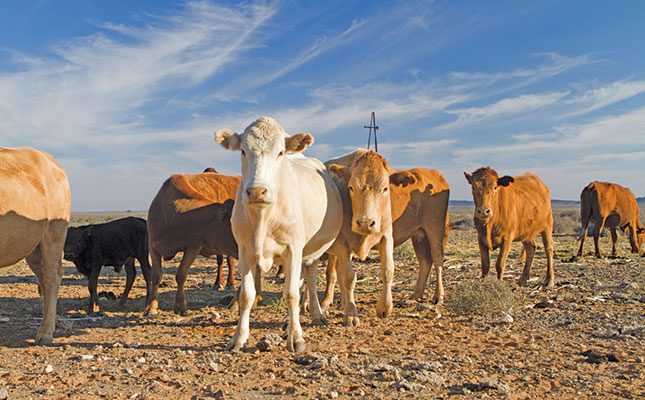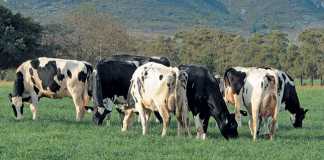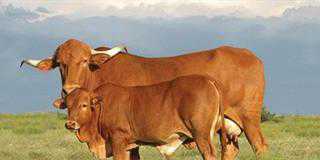
Photo: FW Archive
More than a billion cows across the globe could be exposed to heat stress by 2100. New research on this topic was recently published in the journal Environmental Research Letters.
In this paper, Dr Michelle North and her co-authors explore the linkages between cattle farming, unchecked climate change and land use practices, and heat stress.
In this cross-institutional, transdisciplinary study, North, a veterinarian and climate change researcher at the University of KwaZulu-Natal, collaborated with three other scientists from South Africa and the US: Dr Chris Trisos, Birgitt Ouweneel and James Franke.
Trisos is an ecologist and climate-change researcher at the University of Cape Town’s African Climate and Development Institute, and Ouweneel is a researcher linked to the same institute. Franke is a postgraduate earth scientist at the University of Chicago.
The team studied how heat stress affects cattle, predicted how land use and emissions may increase heat risk, and recommended adapting farming practices in certain areas. The researchers analysed today’s heat and humidity conditions across the world.
They estimated how these conditions will affect cattle in future decades, depending on different levels of emissions and forms of land use.
They project that cattle will potentially face lethal heat stress in regions such as tropical South America, Central America, Equatorial Africa, and South and Southeast Asia by the end of this century.
Heat stress poses challenges
Their findings underscore heat stress as a present and future challenge for livestock farmers.
Already, for at least 30 days a year, nearly three in every four cows (77%) globally are exposed to conditions likely to induce heat stress. In the tropics, one in every five (20%) animals is exposed to it year-round.
If greenhouse gas emissions remain high, these numbers could jump to 90% and 34%, respectively. The severity of heat stress will also intensify due to rising emissions fuelling climate change.
Cattle in the tropics – including in Africa, South America and Asia – are likely to suffer significantly more extreme heat stress, particularly compared with cattle in the world’s temperate zones.
While the worst-affected countries will be in tropical regions, many other parts of the world will face multiple months of heat stress every year, including parts of Europe and North America. Areas in Japan, Australia and Mexico, among others, will experience 180 or more heat-stress days a year.
Moreover, if emissions trajectories remain high and global warming increases to more than 4°C above the 1850-1900 levels, cattle farming is at risk of becoming unviable in many regions. Milk and meat production could be negatively affected, making it difficult for many livestock farmers to stay in business.
The results show that reducing emissions and maintaining cattle farming at present levels can significantly decrease heat stress by at least 50% in Asia, 63% in South America and 84% in Africa.
The bigger picture emerges
Although heat stress has received much research attention, only a few studies thus far have considered the global risk of heat stress to cattle under climate change.
In this new study, the researchers reviewed 105 documented cases of heat stress in cattle to pinpoint the thresholds at which they start producing less milk and meat, and have lower fertility but higher mortality rates.
Their research now provides a bigger picture of the global risk of heat stress. Increasing heat stress affects animal welfare, farm productivity and food security.
The researchers projected the impact of emissions on heat stress in cattle under different climate scenarios, how future land use decisions will affect heat stress, and mapped this globally.
They used climate models and employed the temperature-humidity index in their calculations.
Under all future scenarios, cattle will likely suffer most in tropical regions, where the severity of heat stress will be highest (especially in the Congo Basin, India, and parts of the Amazon).
In Australia, China, Japan, the US and Mexico, cattle could experience potentially lethal heat stress for six months or more per year.
In Africa, the risk of heat stress in cows could increase tenfold by the end of the century. Deforestation and overall cattle farming expansion in the Congo Basin increase global climate risks, expose more cattle to potentially lethal extreme heat conditions, and cause more global warming.
Cattle farming in the Sahel is at high risk, as the region has a high severity of heat stress and high cattle density.
Livestock in Angola, the Central African Republic, the Democratic Republic of the Congo, Kenya, Ethiopia and Uganda are particularly vulnerable, with these regions already experiencing year-round heat stress.
The findings show that heat stress in cattle will increase under both low- and high-emission scenarios. If greenhouse gas emissions are very high, nine out of 10 cows (90%) could experience 30 days or more of heat stress per year. A third of cows (34%) will experience it all year round.
North says these results are “concerning”, as cattle make up the largest share of livestock globally. Millions of people, including resource-poor farmers in low-income countries, depend on cattle for their livelihoods and food security.
Extreme heat negatively affects cattle, especially dairy cows, reducing milk yield and fertility, and compromising their immune systems and welfare.
These impacts on animals are also likely to be compounded by future temperature increases combined with high humidity.
All of these factors have an impact on the viability of livestock farming, reducing animal welfare and farm income.
Future pathways
In this study, development choices emerged as a key factor that is likely to affect heat stress in the future. These choices will influence how many animals will be exposed in the future, particularly in the tropics.
The data provides evidence of the consequences of climate change and development trajectories for cattle farming.
This could have significant implications for the viability of cattle farming in countries where it is currently a major occupation, such as India, Brazil, Paraguay, Uruguay, Argentina, and in the Sahel and East Africa.
The researchers stress that today’s decisions will be critical for the coming decades. For example, cutting down tropical forests to farm livestock in places like Central Africa and the Amazon will not only increase the number of cattle in areas that are already experiencing the most heat stress, but will also worsen climate change, making cattle ranching extremely difficult in these regions and elsewhere.
“Expanding cattle production by cutting down or burning tropical forests is unsustainable,” North warns.
“It worsens climate change and will undermine the welfare of hundreds of millions more cattle that will be exposed to severe, year-round heat stress.”
People reducing the number of cattle products in their diets could also help limit the further expansion of cattle farming, thereby creating opportunities to protect and restore forests that can help curb global warming, the results indicate.
Adapting to change
As temperatures and humidity levels continue to rise, farmers are faced with the challenge of adapting their systems and practices to changing planetary conditions.
“Changes in water availability, which we did not consider in this study, could make cattle farming even less viable in some regions,” North adds.
“Heatwaves and other extreme events could also have compounding effects on cattle.”
North emphasises that farmers need to adapt their systems and practices to changing planetary conditions.
She says that farmers can take simple steps to reduce heat stress in their cattle and reduce emissions in the process.
This may involve providing better ventilation or even air-conditioning for their livestock, and selecting heat-adapted breeds or other livestock species, like goats or camels.
However, certain measures to help cattle cope with severe conditions will become increasingly expensive as climate change continues and may not be possible in all regions.
“In the absence of transitions to more sustainable food production and consumption pathways, increasing demands for livestock protein, combined with climate change, will undermine the productivity and welfare of hundreds of millions of cattle exposed to severe heat stress,” Trisos adds in a related press release.
“Farmers must implement strategies to improve their cattle’s welfare, productivity, and subsequently their own bottom line,” North concludes.
Email Jorisna Bonthuys at [email protected]










